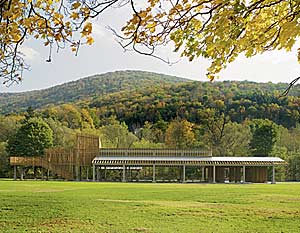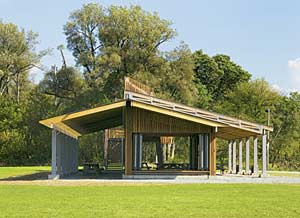Design-build educators talk pedagogy and real politick.
Architectural Record: Steve, I’ve heard that you think design-build studios should operate under the radar rather than speak with the press.
Steve Badanes: I might have said it once, but I think everybody is here for a reason. We’re in constant fundraising mode. And any media attention helps us gain credibility with our schools, which are always questioning what we do, and with the profession in general.


Hank Louis: I remember having a conversation with Cameron Sinclair, wondering how I was going to raise money for a project. He said, “Have you hugged a journalist today?”
AR: Certainly there’s credibility among students: Would you agree that design-build studios are more popular than ever?
Badanes: The students at the University of Washington come here specifically for the Neighborhood Design/Build Studio. That’s true for a lot of other programs.
Adam Hopfner: That’s why I went to Yale, and it’s why a vast majority of the graduate students come here today. Every spring I field at least three or four calls from professors who are trying to start a program at various scales and levels elsewhere. At Wesleyan there’s a guy there with just four kids and they did a design-build studio. Although design-build workshops have been going on for decades, they are now becoming recognized as great learning vehicles.
Louis: Ours is probably the most fledgling of the programs represented at this roundtable, but I’m getting word from students now that they’re coming for DesignBuildBLUFF. That worries me, because we don’t have room for everybody.
AR: Are students saying they’re attracted to your programs for the design-build approach or for the community aspect of the work?
Thomas Dutton: It’s a little bit of both. Our design-build program is very much nestled into the Over-the-Rhine community in Cincinnati, which is undergoing major transformation and gentrification. We’ve been in line with nonprofits whose goal is economic mix, and we try to put buildings back in place for low- and moderate-income people. In some ways there’s a real social mission we’re taking on. The students just love taking a drawing and dealing with budgets and systems and putting all of that into actual practice, but they also appreciate the social aspect.
AR: Surely some students are more intrigued by design-build and others more by the social engagement. How do you balance their needs?
Badanes: There are students who are interested in the social-justice issues and underserved communities. And then there’s an architecture student who wants to build and become a better designer: Everybody here went to school when we were drawing by hand; a drawing is an abstraction of a building, and a computer drawing is an abstraction of a drawing, so there’s a high level of frustration from looking at a computer screen all day.
Hopfner: That’s a really good point. My impression is that students are interested in the Yale Building Project for both reasons. It’s not just learning how to swing a hammer or how something sits on something else, but there’s a real interest in being citizens of a larger community.
To the point about computers, I have this funny anecdote. Students were trying to figure out how to hang fixtures in this large space and modulate the scale. They did all these mockups with hard hats hanging in the space, took photographs of them, and then downloaded them onto the computer and stared at the screen to make their decisions. They had the most accurate mockup in front of them and instead they chose to make it two-dimensional. It made me feel like an old 37-year-old.
David Lewis: In addition to students wanting to bridge between social responsibility and the tectonics of architecture, a number of my Parsons students have done internships at larger firms where often they’ve been involved in projects up to schematic design, particularly with firms doing large works in Asia and the Middle East; they have no sense of how things go together because it’s not their responsibility. We have a students coming in with the experience of doing million-square-foot malls, but they want to experience the exact opposite as a pedagogical challenge to themselves.
Andrew Freear: The nice thing about design-build is that it exposes students to working in teams and accepting that you may not be great at everything. It allows them to grow in self-confidence in terms of working in teams and accepting they don’t have to be a genius in everything. Like most people on this roundtable, I went through an education that was essentially a star system: You sit at your computer or your desk and you’re expected to be wonderful at everything.
Dan Rockhill: My experience is that young people today can’t do much of anything with their hands. Today you can’t even build a tree fort or change a tire. I think that translates to the comfort level people have with putting things together. I think that’s why so much architecture is crappy—it’s assembled out of catalogs. The design-build experience demystifies something students have never even tried.
Louis: My students come for the hands-on experience. But once we get to the Navajo reservation the whole social aspect of it becomes very strong and there’s a love affair that develops between the Navajo family and these students. They come back to remodel parts of the house that don’t seem to be working. Dan Rockhill’s design-build is the last thing students do before graduating. Ours is the first thing we do. I discover there’s a lot of letdown once the students get back.
Badanes: But there’s a lot less deprogramming.
AR: What do you mean by that, Steve?
Badanes: We teach the notion that creativity is a solitary endeavor. You can keep whatever hours you want, as long as you show up and defend your drawings. Getting out there is a rude awakening. Although some design-build programs work by competition, you still have to get everybody to agree or there won’t be group ownership. I like the idea that Hank starts that way.
Freear: There’s a lot of pressure to turn the Rural Studio into a master’s program, from a financial point of view. I try to resist it, because the students spend one year digging themselves huge holes and spend another year digging themselves out.

Post a comment to this article
Report Abusive Comment